Welcome to the exciting world of RVs and Campers! RVs, or recreational vehicles, offer a unique way to travel and freedom on the road to explore the world around you or to live in. Motorhomes, travel trailers, fifth wheels, and camper vans are the main types. Each type of RV and RV class has its own distinct features and pros and cons. In this RV buyer guide, let’s explore the different types of RVs and campers to find out the perfect one for you.
Table of Contents
Classifications of the Different Types of RVs and Campers
The different types of RVs and campers can be classified into two main categories: motorized and towable recreational vehicles.
- Motorized types of RVs are often called drivable RVs. As the name suggests, they are vehicles that can be driven on their own. The types of RVs in this category are motorhomes, which are classified into three main classes (A, B, and C).
- Towable types of RVs, as the name suggests, are trailers that need to be towed by a separate vehicle.
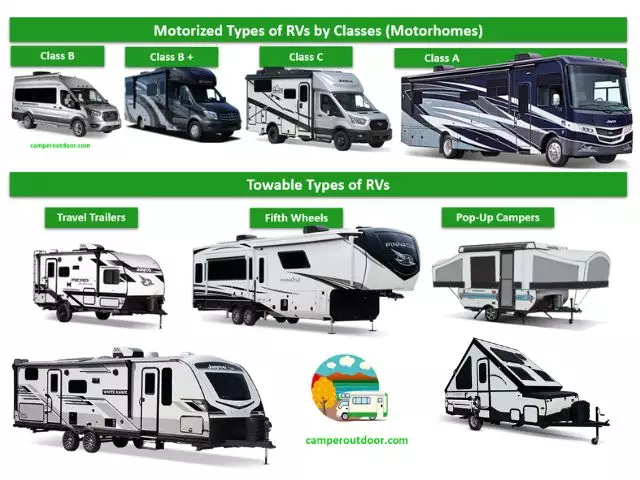
Is a Camper Considered an RV?
At this point, it is important to mention that the terms “RV” (Recreational Vehicle) and “camper” are often used interchangeably. However, they can refer to different things depending on the context. “Camper” is often used informally to describe any RV, but it generally brings to mind smaller, towable RVs.
Therefore, for instance, a pop-up camper is considered an RV because it is a towable recreational vehicle.
RV Class Chart: An Overview
This table summarizes an overview of the classifications of the different types of RVs and campers. Understanding these classifications can help you determine which type of RV is best suited for your needs.
| Types of RVs and Campers | Class/Type | Description | Average Length Range (ft) |
| Motorized RVs | Class A | Large, luxurious, bus-like RVs with spacious interiors. | 30 to 45 ft |
| | Class B | Compact camper vans with basic amenities for easy travel. | 17 to 23 ft |
| | Class C | Intermediate-sized RVs with a truck or van chassis. | 20 to 32 ft |
| Towable RVs | Travel Trailers | Towed by a vehicle, offering various sizes and amenities. | 12 to 35 ft |
| | Fifth Wheel Trailers | Towable with a special hitch, known for spacious interiors. | 25 to 45 ft |
| | Pop-Up Campers | Compact trailers with foldable sides for easy towing. | 8 to 20 ft |
| | Truck Campers | Compact campers loaded onto the bed of a pickup truck. | 8 to 20 ft |
| Special RVs | Toy Haulers | Include space for transporting recreational vehicles. | 20 to 45 ft |
| | Park Model Trailers | Designed for long-term stays in RV parks, resembling cabins. | Variable |
| | Off-Road RVs | Built for rugged terrain and off-grid camping adventures. | Variable |
In the upcoming sections, we explore further the different types of RVs and Campers classes.
Motorized Types of RVs
Motorized types of RVs, also known as motorhomes or drivable RVs, are categorized into three main classes based on their construction and size, and all of these classes are motorized and designed to be driven. The three main types of RVs or classes of motorhomes are Class A, B, and C.
Different RV Classes
When we talk about the different RV classes, we are primarily referring to motorized RVs, not towable trailers. There are three classes (of motorhomes) that stand out: Class A, Class B, and Class C.
- Class A RVs are the largest and most luxurious motorhomes. They resemble a bus or a home on wheels, providing spacious interiors and a wide range of amenities. Class A RVs are perfect for those seeking a luxurious and comfortable RV experience.
- Class B RVs, also known as campervans, are smaller and more compact. They are easier to maneuver and park, making them ideal for solo travelers or couples. Despite their smaller size, Class B RVs still offer essential amenities and a cozy living space.
- Class C RVs fall in between Class A and Class B. They offer a balance of size and amenities, making them a popular choice among RV enthusiasts. Class C RVs are versatile and suitable for families or larger groups.
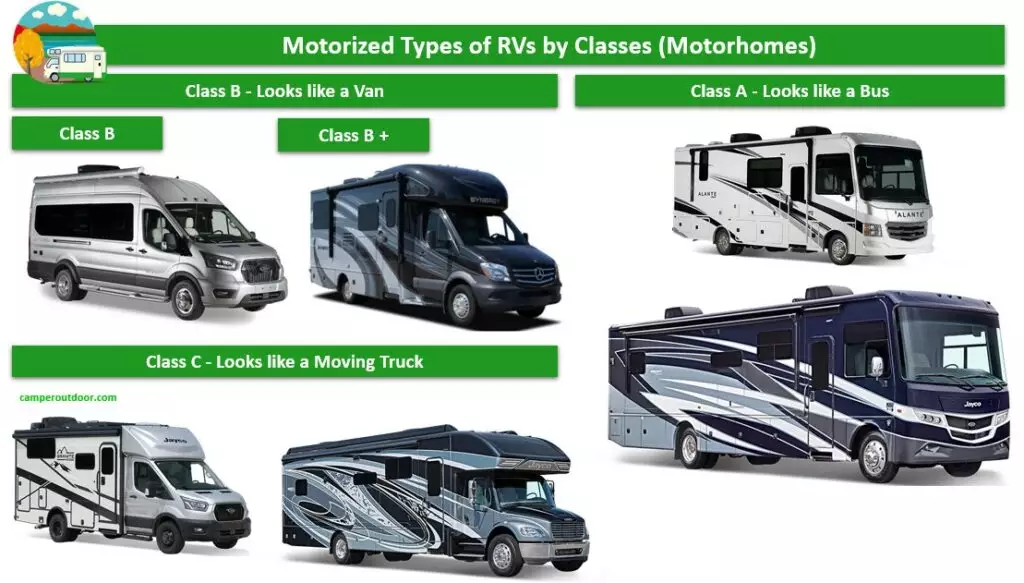
In the following sections, we delve deeper into each class, exploring their distinctive features, popular models, and uses. So, let’s dive in and discover which RV class is the perfect fit for your adventures.
Class A RVs: Diesel and Gas Motorhomes
Class A RVs are known for their luxurious and spacious interiors. They are typically the largest and most extravagant motorhomes on the market. Within the Class A category, there are further distinctions based on the type of engine used in these motorhomes. The two main types of engines for Class A motorhomes are diesel and gas.
Regardless of the type of engine, Class A RVs offer a wide range of amenities, including full kitchens, multiple bedrooms, and even washer/dryer units. These motorhomes are commonly used for long-distance travel, family vacations, and full-time living due to their spaciousness, luxury, and amenities.
- Large, bus-like vehicles.
- Often the most luxurious and spacious.
- It can include amenities like full kitchens, bathrooms, and entertainment systems.
- Some states may require a non-commercial Class B or Class A license if the motorhome exceeds a certain weight threshold. Therefore, it’s crucial to check with your local Department of Motor Vehicles (DMV) or equivalent licensing authority to get accurate and up-to-date information on the specific licensing requirements in your area.
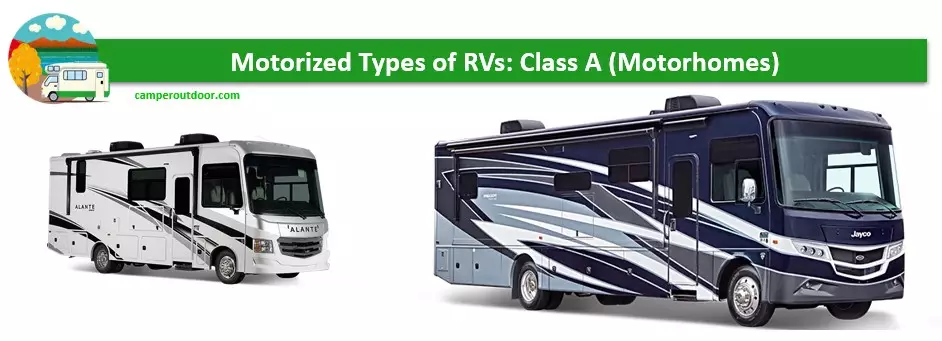
Choosing the Right Class A RV: Diesel vs. Gas Motorhomes
The following table compares key features between Class A Diesel Motorhomes and Class A Gas Motorhomes, helping prospective RV buyers make informed decisions. It highlights differences in engine type, location, noise level, fuel efficiency, torque, initial cost, and suitability for long-distance travel or towing.
| Characteristics of Motorized Types of RVs Class A | Class A Diesel Motorhomes | Class A Gas Motorhomes |
| Engine Type | Diesel | Gasoline |
| Engine Location | Rear (diesel pusher) | Front |
| Noise Level | Quieter (engine at the rear) | Engine noise may be more noticeable |
| Fuel Efficiency | Generally higher | Generally lower |
| Torque | Higher | Lower |
| Initial Cost | Higher | Lower |
| Long-Distance Travel/Towing | Well-suited | Suitable |
Class B Motorhomes (Camper Vans)
Class B RVs, also known as campervans, are smaller and more compact. They are easier to maneuver and park, making them a popular choice for solo travelers or couples. Despite their smaller size, Class B RVs still offer essential amenities and a cozy living space. They are ideal for those who value flexibility and simplicity in their travels.
- Smaller and more compact, resembling oversized vans.
- Easier to drive and park compared to larger RVs.
- Limited living space but can include basic amenities like a small kitchen, bathroom, and sleeping quarters.
- Typically, a standard driver’s license is sufficient.
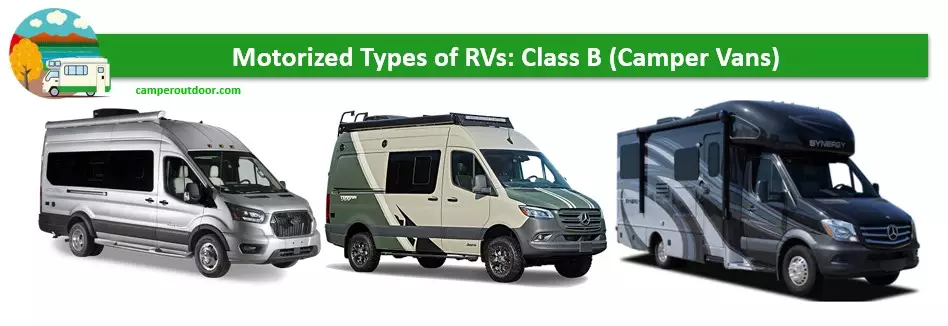
Class C RV
Class C RVs fall in between Class A and Class B. They offer a balance of size and amenities, making them a versatile option for families or larger groups. Class C RVs typically feature a sleeping area above the cab, providing additional sleeping space. They are a popular choice for those who want a comfortable living space with the convenience of a smaller motorhome.
- Intermediate in size, falling between Class A and Class B.
- Built on a truck or van chassis with an attached cab section over the driver’s area.
- Often recognizable by a sleeping area or additional storage space over the cab.
- Drivers usually need a standard driver’s license, similar to Class B motorhomes.

Pros and Cons of Drivable RV Types: Class A, B, and C RVs
When it comes to choosing an RV, understanding the different classes is essential. To help you make an informed decision, we have prepared a table that summarizes the key differences, pros, and cons between these classes.
| Motorized Types of RVs | Class A Motorhomes (Diesel or Gas) | Class B Motorhomes (Camper Vans) | Class C Motorhomes |
| PROS | | | |
| Size and Space | Spacious interiors with various floor plans. | Compact, easy to drive and maneuver. | Good balance of size and living space. |
| Amenities | Luxurious features, full kitchens, and bathrooms. | Basic amenities in a smaller space. | Well-equipped with various amenities. |
| Comfort | Comfortable living with residential-like features. | Cozy but limited living space. | Comfortable living with decent amenities. |
| Maneuverability | Larger size, may be challenging in tight spaces. | Easy to drive, park, and maneuver. | Easier to maneuver than Class A. |
| Fuel Efficiency | Typically, lower fuel efficiency due to size and weight. | Efficient fuel consumption. | Moderate fuel efficiency. |
| Cost | Higher initial cost and operating expenses. | Lower initial cost and operating expenses. | Moderate initial cost and expenses. |
| CONS | | | |
| Size for Urban Areas | Challenging to navigate and park in urban areas. | Well-suited for urban areas. | Easier than Class A but may face challenges. |
| Ease of Setup | Longer setup time due to size and complexity. | Quick and easy setup. | Moderate setup time. |
| Towing Capacity | Generally lower towing capacity. | Not designed for towing. | Moderate towing capacity. |
| Storage | Ample storage options. | Limited storage space. | Storage options vary. |
Towable RVs
Towable types of RVs include travel trailers, fifth wheels, and pop-up campers. These types of RVs are designed to be towed by a vehicle, providing flexibility and convenience for travelers.
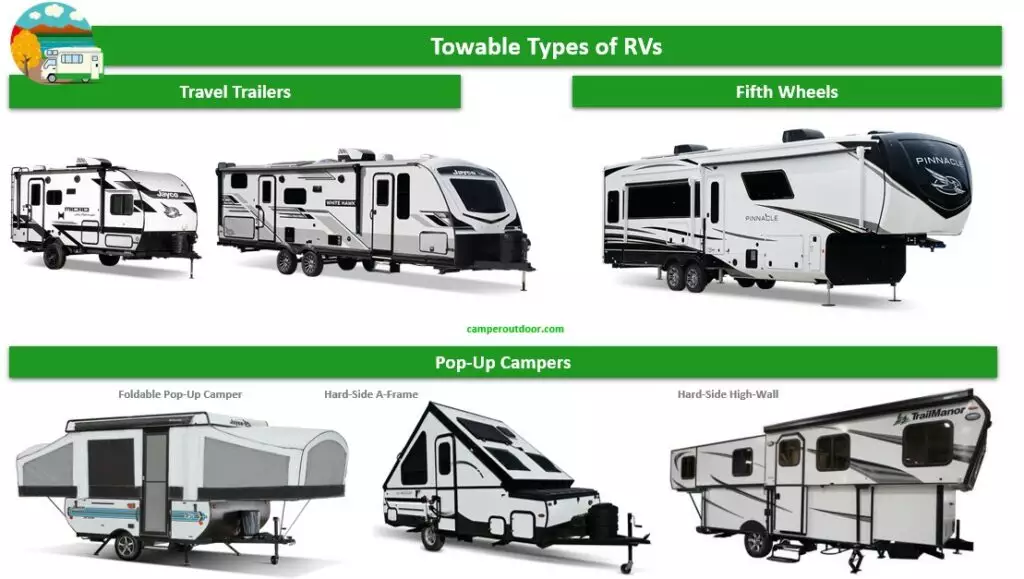
When considering towable RVs, it’s important to assess your towing capacity, as well as your desired level of comfort and amenities, to suit your needs and preferences best.
Travel Trailers
Travel trailers are the most common type of towable RV. They come in various sizes and floor plans, offering a comfortable living space with amenities such as kitchens, bathrooms, and sleeping areas. Travel trailers are versatile and can be easily unhitched from the towing vehicle, allowing campers to explore their surroundings without the need for a separate vehicle.
- Towed by a vehicle, usually a truck or SUV.
- Range in size from small, teardrop trailers to larger models with multiple rooms.
- Many amenities, including an outside kitchen, bathroom with tub, and sleeping capacity.
Types of Travel Trailers:
- Conventional Travel Trailers
- Expandable Travel Trailers (with slide-outs)
- Bunkhouse Travel trailers
- Teardrop Campers (Or Tiny Trailers)
- Destination travel trailers
- Toy Haulers trailers
- Off-Road Campers
- Park Model Trailers
- Retro or Vintage Campers
Recommended reading: The BEST Travel Trailers
Recommended reading: The BEST Bunkhouse Travel Trailers Review, Spec & Video
Fifth Wheel Trailers
Fifth wheels, on the other hand, are larger and offer more living space compared to travel trailers. They are designed to be towed by a pickup truck with a special hitch that connects to the bed of the truck. Fifth wheels often feature multiple levels, providing a more spacious interior with separate living and sleeping areas. They are a popular choice for those who prioritize comfort and luxury while on the road.
- Similar to travel trailers but designed to be towed by a pickup truck with a fifth-wheel hitch.
- Generally larger and more spacious than traditional travel trailers.
- It has a raised forward section that extends over the bed of the towing vehicle.
Types of Fifth-Wheel Trailers:
- Standard Fifth Wheels
- Luxury Fifth Wheels
- Toy Haulers Fifth Wheels
- Bunkhouse Fifth Wheels
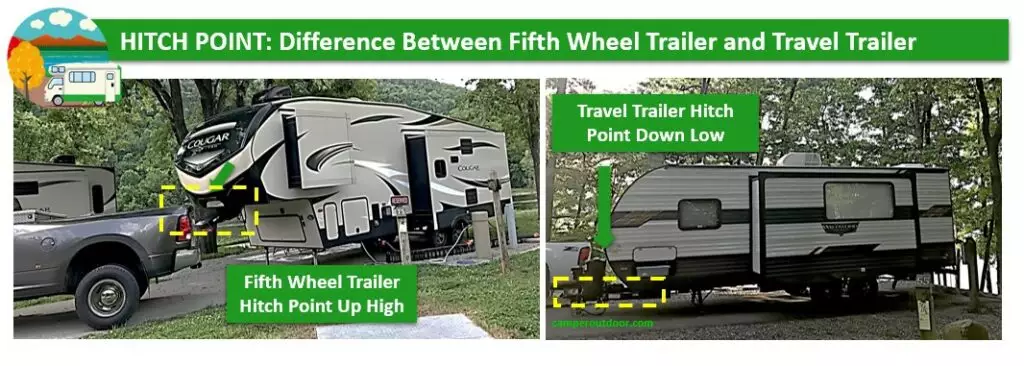
Pop-Up Campers
Pop-up campers, also known as tent trailers, are a more compact and lightweight option. They are collapsible and can be easily towed by a variety of vehicles. Pop-up campers are a great choice for those who enjoy camping in more remote locations, as they offer a closer connection to nature while still providing basic amenities such as sleeping areas and small kitchens.
- Lightweight and compact when folded down for travel.
- Expandable when parked, providing additional living space.
- Often more affordable than larger RVs.
Types of Pop-Up Campers:
- Foldable Pop-Up Campers
- Hard-Sided Pop-Up Campers
- A-Frame Pop-Up Campers
- High-Wall Pop-Up Campers
- Hybrid Campers (a combination of pop-up camper’s foldable ends and a travel trailer)
Recommended Reading: The BEST Pop-Up Campers
Pros and Cons of Towable RV Types: Travel Trailers, Fifth Wheel Trailers, and Pop-Up Campers
The following chart compares the pros and cons of three types of towable RVs: Travel Trailers, Fifth Wheel Trailers, and Pop-Up Campers.
- Travel Trailers: Generally lighter, more maneuverable, and affordable. Spacious interiors but limited luxury features. Suitable for various tow vehicles.
- Fifth Wheel Trailers: Luxurious with extensive amenities, including multiple slide-outs. Requires a larger tow vehicle but provides ample storage and living space.
- Pop-Up Campers: Very lightweight and easy to tow, with a compact design for simple maneuverability. Limited amenities but quick setup and affordability. Suitable for smaller vehicles.
| Aspect | Travel Trailers | Fifth Wheel Trailers | Pop-Up Campers |
| PROS | | | |
| Ease of Towing | Generally easier for smaller vehicles. | Easier to maneuver than travel trailers due to pivot point over the truck bed. | Very lightweight, easy to tow with a variety of vehicles. |
| Living Space | Spacious interiors with various floor plans. | Large and luxurious, often with multiple slide-outs. | Compact when closed, spacious when open. |
| Amenities | Can offer full kitchens, bathrooms, and entertainment systems. | Extensive amenities, including residential features in some models. | Basic amenities, may include sleeping areas and small kitchens. |
| Storage | Exterior storage is typically available. | Generous exterior storage space under the overhang. | Limited interior storage, smaller overall space. |
| Price | Can be more affordable compared to fifth wheels. | Mid-range to high-end pricing, with luxurious options. | Generally more affordable than travel trailers or fifth wheels. |
| Maneuverability | Easier to maneuver and park in tight spaces. | Requires a larger turning radius than travel trailers. | Very easy to maneuver and park due to compact size. |
| Setup Time | Quick and easy to set up at the campsite. | Typically requires more time for leveling and setup. | Quick setup with pop-up design but may require some effort. |
| CONS | | | |
| Interior Height | Limited headroom compared to fifth wheels. | Tall ceilings provide ample headroom. | Limited headroom when closed, taller when open. |
| Weight | Generally lighter, suitable for a broader range of tow vehicles. | Heavier, may require a heavy-duty truck for towing. | Very lightweight, suitable for smaller vehicles. |
| Weather Protection | Less insulation, may be less suitable for extreme weather. | Well-insulated, suitable for extended use in various climates. | Less insulation, may be less comfortable in extreme weather. |
| Luxury Features | Limited in high-end luxury features compared to fifth wheels. | Many luxury features available, including high-end interiors. | Limited luxury features, more basic accommodations. |
| Storage During Travel | Some exterior storage options may be limited. | Generally provides ample storage under the overhang. | Limited storage space during travel. |
Types of RVs for Full-Time Living vs. For Travel
When it comes to choosing the best type of RV for full-time living versus for travel, there are a few factors to consider in determining which type of RV aligns better with your preferences and needs.
- Lifestyle and Intended Use (amenities suitable for the comfort expected)
- Towability or Drivability (Size, Weight, Maneuverable, Special Driver’s License Requirement)
- Budget and Affordability
Best Types of RV for Full-Time Living
For full-time living, one of the most recommended RV types is the Class A motorhome. Class A motorhomes are spacious and offer all the comforts of home, including a separate bedroom, bathroom, and kitchen. They are ideal for those who want a luxurious and comfortable living space on the road.
However, fifth-wheels and travel trailers are also popular options for full-time living because selected floor plans can offer great comfort with features suitable for live-in. These trailers provide ample living space and often have multiple levels, making them feel more like a traditional home.
Recommended reading: Best Travel Trailers for Full-Time Living (& Brands To Avoid)
Recommended reading: Best Full-Time Travel Trailer for a Couple
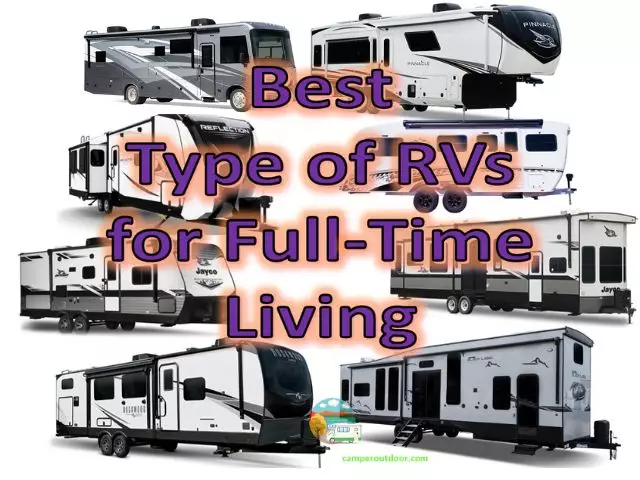
Best Types of RVs for Travel
On the other hand, for those who enjoy the flexibility of traveling to different destinations and exploring new places, towable RVs are a popular choice.
Travel trailers, fifth wheels, and pop-up campers offer the convenience of detachable living spaces, allowing you to use your vehicle for other purposes while at your destination. This is especially beneficial if you plan on sightseeing or engaging in outdoor activities during your trips.
Class B campervans are also a great choice for travel due to their compact size and versatility. They are easy to drive and maneuver, making them suitable for both urban and off-grid adventures.
However, Class A motorhomes allow travelers to tow a car, a jeep, or even a small boat behind the RV. Many people use motorhomes for long trips and stay on the road for weeks or months. When they park at the campsite, they use the vehicle towed by the RV to see the sights or do the groceries. Learn here How to Tow a Car behind an RV.
RV Length Comparison Chart: Motorized and Towable Types of RVs
The size of an RV can significantly impact its maneuverability and camping options. The table below outlines the average length ranges for each RV type in feet, offering a comprehensive guide for those exploring the diverse world of recreational vehicles for each class of motorized and towable types of RVs
| Motorized and Towable Types of RVs | Average Length Range (ft) |
| Class A Motorhomes | 30 to 45 ft |
| Class B RVs (Campervans) | 17 to 23 ft |
| Class C RVs | 20 to 32 ft |
| Travel Trailers | 12 to 35 ft |
| Fifth-Wheel Trailers | 25 to 45 ft |
| Toy Haulers | 20 to 45 ft |
| Pop-Up Campers | 8 to 20 ft |
| Truck Campers | 8 to 20 ft |
Towing Capacity Comparison Chart for Towable RV Types
Towability and drivability are crucial considerations when selecting an RV. Towable RVs, like travel trailers and fifth wheels, require a separate tow vehicle. It’s important to ensure your tow vehicle can handle the weight and towing capacity of the RV. This guarantees safe and efficient towing, preventing strain on your vehicle’s engine and brakes. Factors like hitching, unhitching, and maneuverability while towing should also be considered.
On the other hand, motorhomes are self-contained units that don’t require a separate tow vehicle.
The following chart provides a towing capacities comparison for various towable types of RVs, offering valuable insights for selecting the right vehicle to tow your ideal recreational home on the road.
| Towable Types of RV | Approximated Range of Towing Capacity Required Expressed in Pounds (Lbs.) |
| Travel Trailers | 2,000 to 30,000+ lbs |
| Fifth Wheel Trailers | 12,000 to 30,000+ lbs |
| Pop-Up Campers | 1,200 to 4,000 lbs |
| Truck Campers | 1,500 to 4,000 lbs |
| Toy Haulers | 5,000 to 20,000+ lbs |
| Park Model Trailers | 10,000 to 20,000+ lbs |
| Off-Road RVs | 3,000 to 15,000+ lbs |
Types of RVs and Prices: Comparison Chart Between Towable and Motorized Options
Establishing a budget is a crucial step when considering purchasing an RV. It’s important to consider not only the upfront cost of the RV but also the ongoing expenses associated with owning one. This includes maintenance, insurance, fuel, campground fees, and any necessary upgrades or repairs. By setting a budget, you can ensure that you are financially prepared for the responsibilities that come with RV ownership.
Below is a simplified example of a table comparing the starting prices for new models of different RV types. Keep in mind that these are rough estimates, and you should check with dealerships or manufacturers for the most up-to-date and accurate pricing information.
| Types of RVs and Prices | Average Starting Price Range (USD) |
| Class A RVs | $80,000 – $500,000+ |
| Class B RVs | $60,000 – $150,000+ |
| Class C RVs | $70,000 – $200,000+ |
| Travel Trailers | $15,000 – $80,000+ |
| Fifth Wheel Trailers | $30,000 – $150,000+ |
| Pop-Up Campers | $10,000 – $20,000+ |
| Truck Campers | $10,000 – $50,000+ |
| Toy Haulers | $20,000 – $150,000+ |
| Park Model Trailers | $30,000 – $100,000+ |
| Off-Road Campers | $20,000 – $100,000+ |
Frequently Asked Questions
What Type of RV is in Breaking Bad?
In the TV series Breaking Bad, the iconic RV called “The Krystal Ship” that plays a significant role is a Class C motorhome, specifically a 1986 Fleetwood Bounder RV. This camper plays a significant role in the early episodes of the series as Walter White and Jesse Pinkman use it as a “mobile meth lab“.
What Type of RV Can You Drive in the USA?
The following chart summarizes the driver’s license requirements in the USA according to the type of RV. However, requirements may vary by state (especially for a Class A RV). They might have additional restrictions or endorsements based on specific vehicle characteristics or weight limits. Always check with your local Department of Motor Vehicles (DMV) for the most up-to-date and specific regulations in your state.
RV Types and Driver’s License Requirements Guide
| Type of RVs | Driving License Required in the USA |
| Motorized RVs | |
| Class A | Standard Driver’s License (Class D)* |
| Class B | Standard Driver’s License (Class D) |
| Class C | Standard Driver’s License (Class D) |
| Towable RVs | |
| Travel Trailers | Standard Driver’s License (Class D) |
| Fifth-Wheel Trailers | Standard Driver’s License (Class D) |
| Pop-Up Campers | Standard Driver’s License (Class D) |
| Special Requirements | |
| Exceeding GVWR/GCWR | Commercial Driver’s License (CDL) |
| Length Restrictions | Endorsement or special license may be required |
What Type of RV Can I Drive with a Regular License?
With a regular driver’s license, also known as a Class D license (the Standard Driver’s License), you can typically drive a Class B motorhome.
Final Thoughts
In the pursuit of finding the perfect RV, thorough exploration and consideration are key. Our guide has presented the diverse world of RV types, emphasizing the importance of aligning choices with individual lifestyles.
Beyond just the types, the plethora of amenities, floor plans, and features offered by various RV brands adds another layer of complexity.
Prospective buyers are encouraged to research these specifics, ask pertinent questions, and, whenever possible, rent before buying (Check out How Much Is it to Rent an RV in the USA). This hands-on experience ensures a more tailored decision, allowing individuals to choose an RV that seamlessly integrates with their unique preferences and needs, ultimately enhancing their RVing adventure.
If you are starting to look for your new or next RV, I strongly suggest reading What to Know Before Buying an RV – Checklist
